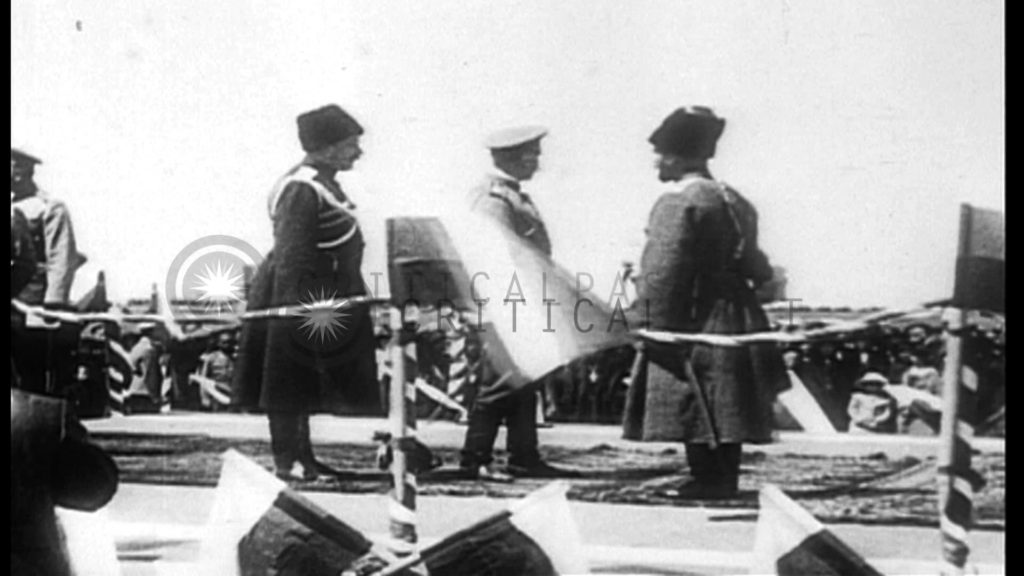
Related

Tsar Nicholas II of Russia reviews drivers and vehicles in World War I. HD Stock Footage

Visit of Russian Czar Nicholas II to Germany, meeting with Kaiser Wilhelm II HD Stock Footage

Kaiser Wilhelm II and Czar Nicholas II meet at a Baltic Seaport. HD Stock Footage

Russian General Grand Duke Nicholas watches the Russian soldiers practice a bayon...HD Stock Footage

Tsar Nicholas II of Russia - Emperor of Russia Nikolay II

Imperial Russian troops moving to engage Bolshevik revolutionary forces in World...HD Stock Footage

Emperor of Russia Nikolay II - Public domain portrait print

Emperor of Russia Nikolay II - Public domain portrait photograph

Russian Emperor Nicholas II arrives in Helsinki in 1915
Russian Emperor Nicholas II arrives to inspect his troops during World War I. HD Stock Footage
Summary
Link to order this clip:
http://www.criticalpast.com/video/65675045895_Russian-Emperor-Nicholas_wears-Cossack-uniform_reviews-troops_soldiers-coming-downhill
Historic Stock Footage Archival and Vintage Video Clips in HD.
Russian Emperor Nicholas II arrives to inspect his troops during World War I.
Russian Emperor Nicholas arrives to inspect troops in Caucasus during World War 1. He wears a Cossack uniform. The troops stand in formation. Nicholas reviews the marching Cossack troops. He talks to an officer. The officers salute him. He stands on a platform with the officials. Slate indicates that the Tsar (Czar) was known by the Russian troops as "Little White Father." Emperor Nicholas II is seen mixing with the Russian soldiers, and leading a column of soldiers in descending a steep hill. (WWI; WW1) Location: Caucasus. Date: 1916.
Visit us at www.CriticalPast.com:
57,000+ broadcast-quality historic clips for immediate download.
Fully digitized and searchable, the CriticalPast collection is one of the largest archival footage collections in the world. All clips are licensed royalty-free, worldwide, in perpetuity. CriticalPast offers immediate downloads of full-resolution HD and SD masters and full-resolution time-coded screeners, 24 hours a day, to serve the needs of broadcast news, TV, film, and publishing professionals worldwide. Still photo images extracted from the vintage footage are also available for immediate download. CriticalPast is your source for imagery of worldwide events, people, and B-roll spanning the 20th century.
There were special court cameramen and photographers who captured the daily life of the Romanov family. The Company of von Gun filmed the Tsar, and with the permission of the Ministry of the Court, showed these films in movie theatres beginning in 1907. Before the February 1917 Revolution, the von Gun Company was the main provider of the Tsar's chronicles in the Russian film industry. After 1907 other filmmakers were permitted to film the Royal family, including A. Drankov, V. Bulla (the elder), Khanzhonkov Company, Pate Company, and others. Before the beginning of World War I a newsreel became popular capturing military parades, holidays, reviews and drills. Many are devoted to the Fleet. They document everyday life of the Baltic Sea and Black Sea squadrons. Some of the newsreels document the fire of the Maly Theatre in Moscow, mass gymnastics, auto and motor races, zoos and animal preserves, and the life of peoples of the Russian Empire. The objects of filming were political and cultural figures, the construction of warships, the Moscow flood, the testing of new agricultural equipment and the oil industry in Baku. There are also films showing the towns of Russia, etc. During World War I, cameramen captured events on all fronts. Before 1915, the exclusive rights to film battles belonged to the Film Department of the Skobelev Committee. The Skobelev Committee of the Assistance to the Wounded Soldiers of the General Staff was founded in November 1904 as a public organization. By the order of the Scobelev Committee many cameramen filmed the events of the World War I, such as Englishman Arcol (representative of Pate Company, filmed on South-Western and Caucasus fronts), cameramen E.D. Dored (represented American companies) and P.V. Ermolov, (filmed events on Caucasus front); P.K. Novitskiy (Gomount Company), N.M. Toporkov, K.E. von Gan, A.K. Gan-Jagelskiy, made filming in the General Headquarters. Other cameramen such as: A. G Lemberg, S, Zebel, Trushe, etc. also worked at the fronts. Cameramen filmed the war not only on the fronts but also from the rear. Since the first month of the war until 1917 the Scobelev Committee produced about 70 newsreels. From 1914 to 1915 cameramen of the Scobelev Committee produced 21 series of the newsreel "Russian Military Chronicle". The materials of this newsreel were used many times for the separate films made by Scobelev Committee and other film companies. Read more at: http://www.pbs.org/redfiles/rao/archives/rgakfd/textind10.html
